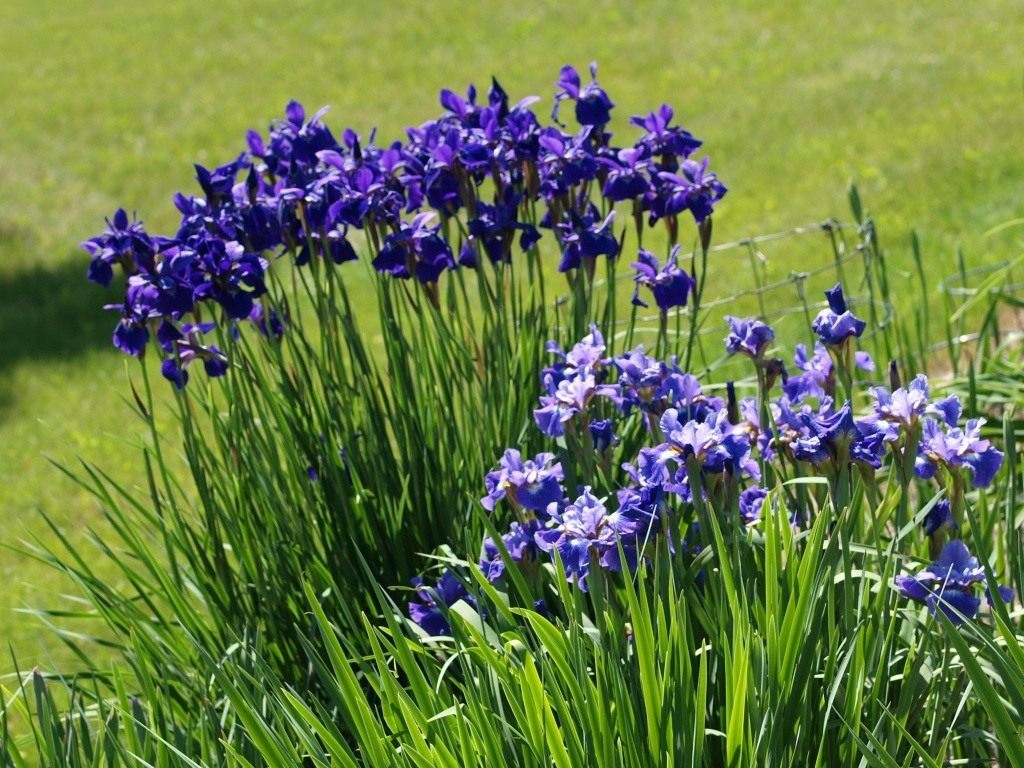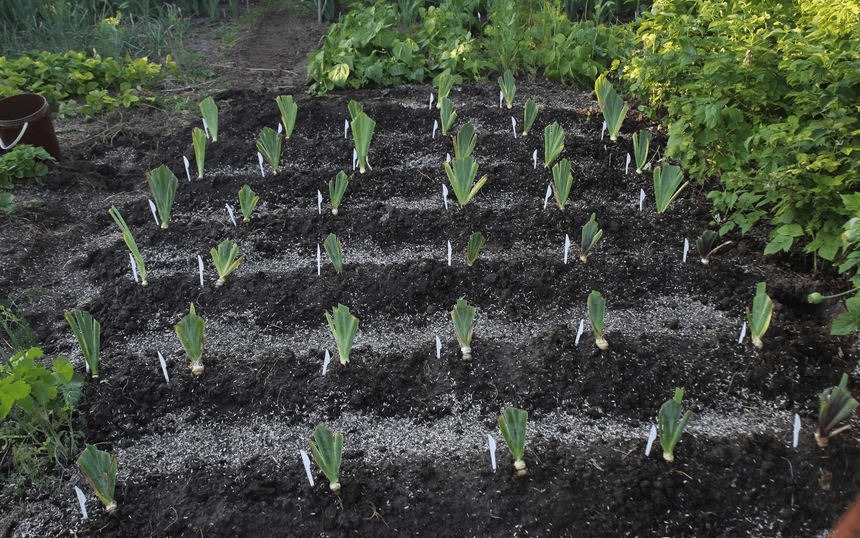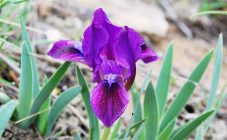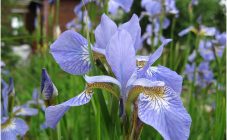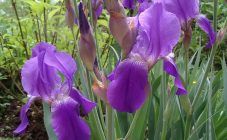Content:
In the floral variety of summer cottages, iridescent flowers stand out for their beauty. A large number of species of this plant are classified into sections, one of them is called limniris, which are characterized by the absence of a beard. The ancestor of a large number of varieties of this species is Siberian iris, which is worth talking about now.
Plant information
These flowers can be seen everywhere: from Europe to the Far East. The common name of the species comes from the name of the rainbow goddess - Iris. This is no coincidence - among the varieties of iris there is such an abundance of colors that, by combining them on one plantation, it is easy to count all the shades of the spectrum.
Despite the name of the group, Siberians are selected mainly in Holland and Germany. The name reflects the ability of irises to winter in the open field even in severe winter conditions.
The main purpose of the killer whales is landscape decoration. Flowers look good in large rockeries, on alpine hills, near ponds and yard buildings. It is enough to plant one root, and in a couple of years there will be a gorgeous bush in this place.
Iris Siberian Iris is also a medicinal plant, in which the rhizome is the most valuable. This part of the flower contains essential oils, resins, starch, tannins, flavonoids, mucus, and sugars. This composition determines the widespread use of iris in traditional medicine:
- healers call the raw material "tooth root", which already determines the main application;
- decoctions and infusions are used for diseases of the upper respiratory tract, as an expectorant;
- in case of problems with the gastrointestinal tract, the rhizome of iris gives an enveloping effect;
- homeopaths recommend using drugs for sciatica and migraines;
- since ancient times, wounds have been sprinkled with powder for quick healing.
Characteristic
Siberian Iris is a perennial herbaceous plant. Many varieties of this species are characterized by a complete lack of aroma, despite the fact that the root contains a lot of esters. A description of the plant can be presented in the table.
| Plant parts | Features: |
|---|---|
| Stem | Strong, branched at the top. On average, it reaches a height of 1-1.2 m |
| Leaves | The aerial part is large, xiphoid. On the stem - numerous, linear, in the upper part - reduced. All have a rich gray-green hue |
| Flowers | Large, located on peduncles in the axils of the upper sheets. The perianth is actinomorphic, six-partite. The color depends on the hybrid variety, but lily and violet-blue are more common |
| Fetus | Box 3-celled, which contains many flat small seeds |
| Rhizome | Fleshy, thick, branched-creeping, giving numerous thin roots located close to the surface of the earth. Usually the color of the rhizome is white |
What does Siberian iris look like?
The iris blooms in May and early July and pleases with its beauty throughout the summer. It is recommended to keep the plant in one place for no more than 5 years, then plant it in new areas.
Characteristics of species and varieties
Each varietal hybrid of irises is worth planting in your flower bed. Below is a description of the most popular representatives of this group of iris.
Varieties of Siberian irises
| Name | Features: |
|---|---|
| Irises Concord Crash | Blue-violet flowers with a diameter of 15 cm are formed on meter-long stems. At the base, you can see a light yellow center. The variety is unpretentious and develops well even in a shaded place. |
| Moon Silka | The stem is low - barely reaches 90 cm. The size of the flowers is small - 10 cm in diameter. It attracts with the color of the petals - extreme light yellow, turning into an orange tint at the base. Inner petals are pale white with a slightly perceptible creamy coating. Prefers to grow in a well-lit area |
| Irises Miss Apple | Graceful representative of the species with large multi-petaled flowers. The middle ones are painted in violet-lilac tones, the outer ones are rich burgundy with a yellow ornament at the base |
| Iris Germanic Sia Double | It stands out in the flower bed in rich blue shades with individual blue petals. Irises Sia Double are winter-hardy and develop well in partial shade, giving large buds (up to 15 cm) on meter stems |
| Iris Pink Parfate | A distinctive feature of this variety is that the delicate lilac flower is similar in structure to a rose, which makes it especially popular among gardeners. Starting to bloom in June, exudes a strong aroma for 1.5-2 months |
You can find many more varieties of Siberian irises, which stand out in blue, blue, purple, lilac, white shades. To those already described in the table, you can add Kita no Seiza, Having Fan, Harpswell Happiness, Butter and sugar, Sparkling Rose, Hubbard, Imperial Opal, Kaboom, Double Standard.
Landing
Planting and caring for Siberian iris is identical to the agricultural technology of other groups. But there are still some features, they should be considered in detail.
Site preparation
Despite the winter hardiness, irises prefer to grow in sunny flower beds, but they can be planted in partial shade. More attention should be paid to the soil, because in one place the flowers will grow for several years. Therefore, the soil on the site must be sufficiently nutritious.
Slightly acidic or neutral soils are most attractive for culture, therefore loams are most suitable. If a heavy acidic earth is found, it is "diluted" with sand and lime. Alkaline soil is supplemented with peat.
Having cleared the land of weeds, they dig it up and loosen it well. If a vacant lot is chosen for planting, then it is better to ennoble it under a flower bed in advance, in the fall, in order to use it next year.
Landing rules
The planting of Siberian irises in open ground is usually carried out in the second half of August - early September. But the spring option is also allowed - the first decade of May. It is not advisable to break this schedule - a late planting in the spring will lead to plant diseases, and in late autumn the killer whales will not have time to take root.
When planting in prepared soil, holes are made. Their depth is determined by the length of the roots, which should fit freely in the fossa without bending. The seedlings are placed vertically in the hole, covered with earth, squeezed and watered.
To make the iris more comfortable to root in a new place, the ground around the plant is covered with mulch (peat, freshly cut grass or compost), with a layer of 5 cm.If hot weather is hot, it is recommended to make a temporary canopy over the flowers or shade with branches stuck next to them with foliage.
When planting several bushes on the same lawn, the gap between the plants is kept at 0.6-0.7 m. If iris are used to decorate mixborders, then the planting can be compacted to 25-40 cm. But then every 3 years such a "fence" will have to be thinned out.
How to care
Cultivation of beardless killer whales does not require special skills, everything is as usual: loosening the soil, removing weeds, moistening, feeding, sanitary assistance.
Watering
Special attention is paid to irrigation of flower beds - irises prefer not only moist soil, but also do not like dry air. Although the plants should not be poured daily, so as not to harm - the site becomes alkalized from this. It is better to periodically change the mulch on the flower bed, which will not only retain the required amount of moisture, but also prevent weeds from developing.
It is necessary to choose the right time for watering: early in the morning or in the evening sunset. At the same time, they try not to fall on the petals, otherwise they will lose their attractiveness.
Nutrition
In order for irises to be presented with full-fledged flowers, they should be regularly fed, this is done in several passes:
- as soon as the first greens appear on the bushes, sprinkle mineral water on the flower bed (for example, kemira); so that the granules do not damage the plant, the fertilizer is carefully embedded in the soil;
- during the budding period, it is recommended to use organic matter (fermented grass, slurry, compost), adding a small amount of a mineral complex;
- the last call is carried out after flowering to nourish the weakened plant; at this time, phosphate-potassium fertilizers are best suited.
When to transplant Siberian irises
The moment comes when you need to change your "place of residence". On one site, irises can bloom for 12-15 years, filling the entire plantation. During this period, the plant weakens, because the old rhizomes do not allow the young to bloom at full strength.
It is more rational to transplant irises in 5-6 years, selecting strong "children" for reproduction. It is better to throw away too old and diseased rhizomes so that they do not take up space.
Relocation of irises is carried out 2-4 weeks after the petals wilt. Before digging the bush, the peduncles are completely cut off, shortening the leaves in half. After digging, the plant is dissected into several bushes and planted in new places, deepening by 5-7 cm.
Sometimes it becomes necessary to transplant young bushes if they do not develop well in the flower bed. Then the plant is transferred completely to another area, but before planting its rhizome is shortened by 1/3.
Diseases and pests
Siberian Irises are popular with summer residents not only due to their beauty, but also their ability to resist diseases (unlike bearded ones). With poor agricultural technology and in the rainy season, problems may arise that are recommended to be eliminated immediately.
Fight against diseases and pests of Siberian irises
| Disease | How to treat |
|---|---|
| Rust | Copper oxychloride - 0.5% solution |
| Scorch | Sulfur suspension - 0.8%. In case of severe damage, the bushes are burned, the soil is treated with formalin, chlorine or potassium permanganate |
| Caterpillars | Kinmix (1 ampoule per bucket of water) |
| Gladiolus thrips | Infusion of tobacco dust, a solution of laundry soap |
Siberian irises, planting and care in the open field, which require compliance with the rules of agricultural technology, is a good option for landscape design. In order for a frost-resistant variety to calmly endure winters, the bushes need to be prepared: cut the foliage in late autumn, leaving small "hemp", and refresh the mulch.
